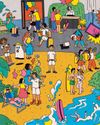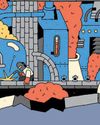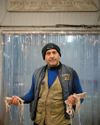A couple of hours from San Francisco, a Dutch Renaissance man truly lived the tech industry’s creation myth—and invented the flying saucer.
An idyllic ease permeates California’s Carmel Valley. Wealthy people have built ranch-style houses into the mountains, giving them views of the Pacific on one side and pine and cypress forests on the other. It’s neither too hot nor too cold, and the fresh ocean air makes you feel calm inside. These conditions, which give big ideas room to grow, have attracted artists to the area, as well as retirees who want to meditate on the good life. But every now and then, the gentle rhythm of this place gets disturbed. Someone’s perfectly manicured existence goes in a turbulent, unexpected direction.
For some people, it’s a real estate shock. For others, it’s an earthquake or—God knows—a wildfire. For Randy Hunter, a local art dealer, that moment arrived in 2008. The financial crisis had come to paradise. Artists and galleries accustomed to a steadyish stream of wealthy collectors fell on hard times. Things got bad enough that Larry Fischer, the owner of a sculpture foundry, decided to auction off pieces he’d held on to for years to help make ends meet. Ahead of the auction, he invited Hunter to come see if there was anything he liked. He guided his friend through the gritty warehouse toward a collection of bronze sculptures he thought might be of particular interest.
He chose well. The first sculpture Hunter saw, Up With Life, was a foot tall and depicted an adult’s face morphing vertically into a hand cradling an infant. Fischer explained that the sculpture, made by an unknown artist named Alexander Weygers after World War II, represented humanity rising up to find hope in the darkest of times. Its beauty overwhelmed Hunter, leaving him giddy and a little dazed. “I freaking started crying,” he later said. As he surveyed the room and saw one magnificent work after another, Hunter knew he had to have them. “I bought the whole collection of 30 Weygers statues.”
This story is from the November 26, 2018 edition of Bloomberg Businessweek.
Start your 7-day Magzter GOLD free trial to access thousands of curated premium stories, and 9,000+ magazines and newspapers.
Already a subscriber ? Sign In
This story is from the November 26, 2018 edition of Bloomberg Businessweek.
Start your 7-day Magzter GOLD free trial to access thousands of curated premium stories, and 9,000+ magazines and newspapers.
Already a subscriber? Sign In

Instagram's Founders Say It's Time for a New Social App
The rise of AI and the fall of Twitter could create opportunities for upstarts

Running in Circles
A subscription running shoe program aims to fight footwear waste

What I Learned Working at a Hawaiien Mega-Resort
Nine wild secrets from the staff at Turtle Bay, who have to manage everyone from haughty honeymooners to go-go-dancing golfers.

How Noma Will Blossom In Kyoto
The best restaurant in the world just began its second pop-up in Japan. Here's what's cooking

The Last-Mover Problem
A startup called Sennder is trying to bring an extremely tech-resistant industry into the age of apps

Tick Tock, TikTok
The US thinks the Chinese-owned social media app is a major national security risk. TikTok is running out of ways to avoid a ban

Cleaner Clothing Dye, Made From Bacteria
A UK company produces colors with less water than conventional methods and no toxic chemicals

Pumping Heat in Hamburg
The German port city plans to store hot water underground and bring it up to heat homes in the winter

Sustainability: Calamari's Climate Edge
Squid's ability to flourish in warmer waters makes it fitting for a diet for the changing environment

New Money, New Problems
In Naples, an influx of wealthy is displacing out-of-towners lower-income workers